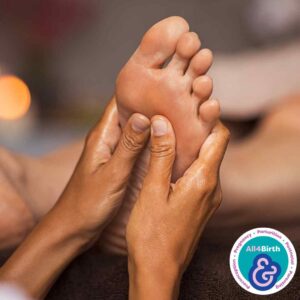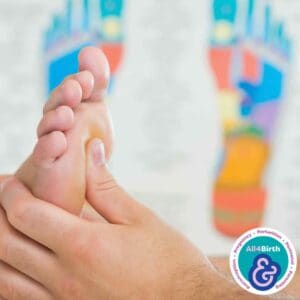Abbie Tomson
Midwife MSc, BSc, Yoga Teacher, Project Lead at All4Birth
@enevlorel
Summary
Birth is a transformative journey marked by a wide range of emotions and sensations, including the discomforts associated with labour contractions. While medical interventions such as epidurals and medications offer effective pain relief for some, others seek alternative methods to manage labour pain. One such method of gaining attention is using a simple comb. This post explores using a comb for pain relief in labour, its potential benefits, and the evidence supporting its effectiveness.
Understanding the Use of a Comb in Labour
Using a comb as a tool for pain relief during labour is rooted in the principles of acupressure and distraction techniques. By applying pressure to specific points on the palm, in this case, the Lao Gong, benefits such as easing anxiety and stimulating endorphins are seen. Its use is based on ‘The Gate Control Theory’, which states that your brain cannot concentrate on more than one sensation at a time. Therefore, squeezing the comb into your palm acts as a distraction, diverting your brain so your body can adjust to the sensations.3
Potential Benefits of Using a Comb for Pain Relief
- Natural Pain Relief: Using a comb offers a drug-free and non-invasive method of pain relief during labour, for those seeking alternative approaches to managing discomfort.
- Empowerment and Control: Holding a comb during labour can provide a sense of empowerment and control, allowing the labouring individual to participate actively in pain management.
- Distraction and Focus: Focusing on the sensation of the comb in their hands can help you redirect your attention away from the intensity of contractions, promoting relaxation and mindfulness.
- Portable and Accessible: A comb is a readily available and portable tool that can be easily incorporated into a labouring person’s birth plan, regardless of their birth setting and can be used alongside other forms of analgesia
Evidence Supporting the Use of a Comb for Pain Relief
While research on using a comb for pain relief in labour is limited, the practice is rooted in principles of acupressure and distraction techniques, which have been studied for their effectiveness in managing pain1, 2 . Additionally, anecdotal evidence and personal testimonials from individuals who have used a comb during labour highlight its potential benefits in providing natural pain relief and promoting a positive birth experience
Practical Tips for Using a Comb in Labour
- Choose a sturdy comb with rounded teeth to avoid discomfort or injury.
- Experiment with different pressure points on the palms of the hands to find what feels most effective for pain relief.
- To find the Lao gong acupressure point, make a fist with your hand and where your middle and ring fingers meet your palm is where the comb needs to go. You would then intermittently squeeze the comb, regularly changing hands so you don’t get sore. It is recommended that you start with a lighter grip and as the contractions build you gradually increase your grip into the peak.
- Practice relaxation techniques, such as deep breathing and visualisation, in conjunction with using the comb to enhance its effectiveness.
- Communicate with your birth team about your intention to use a comb for pain relief during labour and incorporate it into your birth plan.
Conclusion
Using a comb for pain relief in labour is a simple yet potentially effective technique rooted in principles of acupressure and distraction. While more research is needed to understand its mechanisms and benefits fully, many individuals find comfort and relief in holding a comb during contractions. Whether used as a standalone method or in conjunction with other pain management techniques, the use of a comb offers a natural and empowering approach to labour pain relief, allowing individuals to navigate childbirth with greater comfort, control, and confidence.
Links to other resources
 Podcast Episodes
Podcast Episodes
References
- – Kafali, H., Derbent, A., Keskin, E., & Simavlı, S. (2013). Acupressure therapy for morning sickness during pregnancy: A randomized controlled trial. Obstetrics & Gynecology, 122(2 Pt 1), 319-324.-
- Hamidzadeh, A., Shahpourian, F., Orak, R. J., Montazeri, A., & Khosravi, A. (2012). Effects of LI4 acupressure on labour pain in the first stage of labour. Journal of Midwifery & Women’s Health, 57(2), 133-138.
- Mendell L. M. (2014). Constructing and deconstructing the gate theory of pain. Pain, 155(2), 210–216. https://doi.org/10.1016/j.pain.2013.12.010












